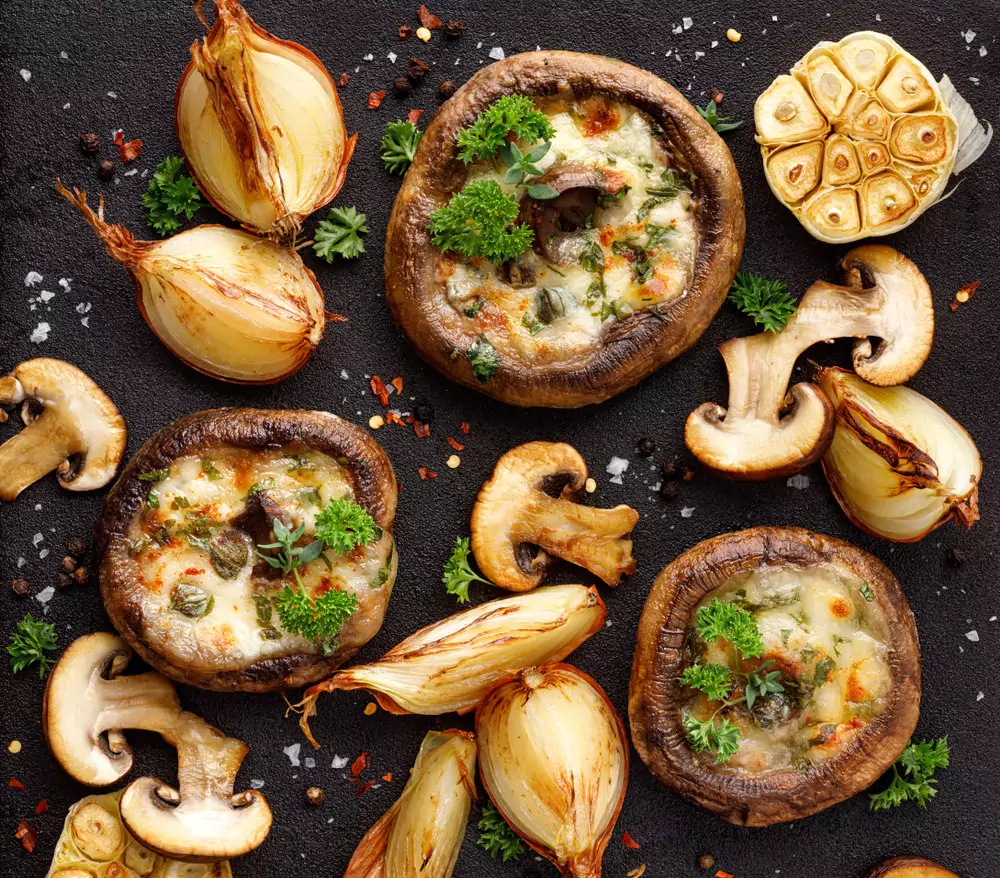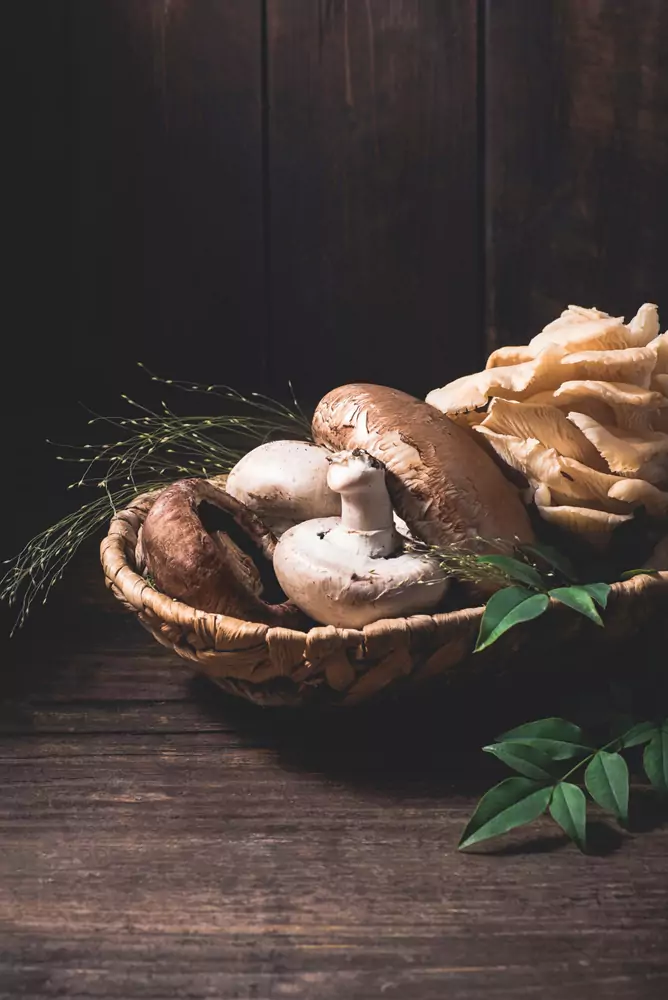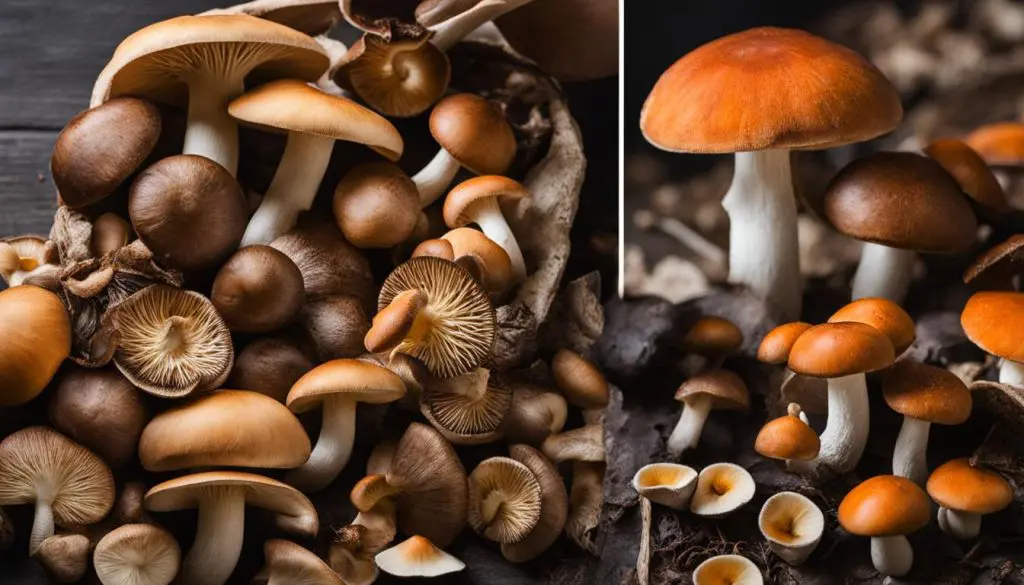Portobello mushrooms have long been hailed as a delicious and nutritious alternative to meat. While portobello mushrooms are a rich source of vitamins, minerals, and antioxidants, they may also pose some risks to our health. For instance, consuming large amounts of portobello mushrooms can lead to adverse reactions in individuals with mushroom allergies. To minimize the portobello mushroom negative effects, it is essential to approach their consumption with caution.
Additionally, some studies have suggested that certain compounds found in mushrooms may inhibit the absorption of essential nutrients, such as iron and zinc. Therefore, in this article, I will explore the potential drawbacks of portobello mushrooms and discuss how to mitigate these negative effects.
What Are Portobello Mushrooms?
Portobello mushrooms, also known as “crimini mushrooms” when young, are a type of edible fungi belonging to the Agaricus genus. They are large, dark brown, and have a meaty texture, making them a popular choice for those looking for a vegetarian or vegan alternative to meat.

Health Benefits
Portobello mushrooms are a versatile and nutritious food option that can be incorporated into various dishes. These mushrooms, also known as “crimini mushrooms” when young, are a great source of essential nutrients and have numerous positive and negative effects.
Some of its benefits are:
Rich in Nutrients
Portobello mushrooms are an excellent source of vitamins, minerals, and antioxidants. They are particularly high in B vitamins, selenium, and potassium.
Low in Calories
These mushrooms are low in calories, making them an ideal food choice for those looking to maintain or lose weight. A single cup of raw Portobello mushrooms contains only about 20 calories.
High in Protein
Portobello mushrooms are a good source of plant-based protein, containing around 3 grams of protein per cup. This makes them a valuable addition to a vegetarian or vegan diet.
Fiber-Rich
These mushrooms are also a good source of dietary fiber, which can help improve digestion and maintain regular bowel movements.
Immunity Booster
The antioxidants present in Portobello mushrooms, such as selenium and ergothioneine, help boost the immune system and protect the body from harmful free radicals.
Heart Health
The high levels of potassium in Portobello mushrooms can help lower blood pressure and reduce the risk of heart disease.
Cancer Prevention
Some studies have suggested that the antioxidants and other compounds found in Portobello mushrooms may help prevent certain types of cancer, such as breast and prostate cancer without altering the DNA.
Skin health
The high levels of antioxidants found in portobello mushrooms, such as selenium and vitamin C, can help protect the skin from damage caused by free radicals. This can lead to a reduction in signs of aging and a healthier, more radiant complexion.
Kidney health
Portobello mushrooms are rich in potassium, which is essential for maintaining proper kidney function. Potassium helps regulate blood pressure, prevent kidney stones, and maintain the balance of fluids in the body.
Liver health
The high levels of antioxidants in portobello mushrooms, such as glutathione, can help support liver health. Glutathione is a powerful antioxidant that helps protect the liver from damage caused by toxins and excessive alcohol consumption.
Potential Side Effects Of Portobello Mushrooms
Other than the benefits, there are a few potential side effects of consuming Portobello mushrooms. It is essential to be aware of these side effects to ensure that you can enjoy the delicious and nutritious fungi without any health concerns.

Short Term Effects
Allergic reactions
Some people may experience an allergic reaction to Portobello mushrooms, which can include symptoms like itching, hives, and swelling. If you suspect an allergic reaction, it is crucial to consult a healthcare professional.
Stomach discomfort
Overconsumption of mushrooms, including Portobello, may lead to stomach discomfort, bloating, and gas. To avoid this, it is recommended to consume mushrooms in moderation.
Drug interactions
Portobello mushrooms contain a compound called cholorogenic acid, which may interfere with the absorption of certain medications, such as thyroid hormone replacement therapy and blood thinners. It is essential to consult a healthcare professional before adding Portobello mushrooms to your diet if you are taking any medications.
Long Term Effect
Nutrient deficiencies
While Portobello mushrooms are nutritious, they may not provide all the essential nutrients required for a balanced diet. Consuming large amounts of mushrooms may lead to nutrient deficiencies if not combined with other food sources.
Liver toxicity
Some studies have shown that certain types of mushrooms, including Portobello, may contain toxins like hydrazine that can cause liver damage when consumed in large amounts over a long period. It is essential to consume mushrooms in moderation and avoid consuming large quantities regularly.
Pesticide exposure
Portobello mushrooms, like other produce, can contain residues from pesticides used in their cultivation. While the levels are generally considered safe, long-term exposure to these chemicals may pose health risks. Always wash mushrooms thoroughly before consumption and choose organic varieties when possible.
Vitamin D Deficiency
Mushrooms are often touted as a good source of vitamin D, but it is essential to note that portobello mushrooms do not provide the same level of vitamin D as other sources like sunlight or fortified foods. A deficiency in vitamin D can lead to weak bones, fatigue, and mood changes.
High Oxalate Content
Portobello mushrooms contain a significant amount of oxalates, which can contribute to the formation of kidney stones in some individuals. Those with a history of kidney stones or oxalate sensitivity should limit their consumption of portobello mushrooms.
Fungal Contamination
Mushrooms are grown in a natural environment, which increases the risk of contamination with harmful fungi. Consuming contaminated mushrooms can lead to foodborne illnesses or other health complications.
Environmental Impact
The cultivation of portobello mushrooms can have a negative impact on the environment, particularly due to the use of artificial lighting and the production of waste. This may contribute to climate change and other environmental issues.
Cooking And Eating Portobello Mushrooms
Do you know that Portobello mushrooms are a delicious and nutritious alternative to meat? These large, flavorful mushrooms can be cooked in various ways and are perfect for adding to salads, sandwiches, or even enjoyed on their own.

Here, I will share some personal experiences and tips on cooking and eating Portobello mushrooms.
Preparing Portobello Mushrooms
- Start by gently cleaning the mushrooms with a damp cloth or paper towel to remove any dirt. Avoid using water, as it can make the mushrooms soggy.
- Remove the stem from the mushroom by twisting it gently or using a small knife. The stem can be saved for other recipes or discarded.
- For a more visually appealing presentation, slice off the brown gills on the underside of the mushroom cap. This will prevent any staining when cooked.
Cooking Portobello Mushrooms
- For grilling, preheat your grill to medium-high heat and brush the mushrooms with olive oil or a mixture of olive oil and balsamic vinegar. Place the mushrooms on the grill and cook for 4-5 minutes per side, or until tender and slightly charred.
- To bake, preheat your oven to 375°F (190°C) and line a baking sheet with parchment paper. Brush the mushrooms with olive oil and season with salt, pepper, and your favorite herbs. Bake for 10-12 minutes, or until tender and slightly crispy on the edges.
- For a stovetop method, heat a large skillet over medium heat and add a small amount of olive oil or butter. Place the mushrooms in the skillet, cap-side down, and cook for 4-5 minutes, or until golden brown. Flip the mushrooms and cook for an additional 3-4 minutes, or until tender.
Eating Portobello Mushrooms

- Portobello mushrooms can be enjoyed on their own as a main dish, marinated in your favorite dressing and served with a side salad or grilled vegetables.
- They can also be used as a delicious alternative to meat in sandwiches, burgers, or tacos. Try adding your favorite toppings, such as cheese, lettuce, tomato, and a special sauce.
- Portobello mushrooms can be sliced and added to salads for an extra boost of flavor and nutrition.
Conclusion
In conclusion, it is essential to recognize that Portobello mushrooms, while a nutritious and delicious food choice, may have some potential negative effects on certain individuals or when consumed in excessive amounts. As highlighted in this candid discussion, these negative effects include possible allergic reactions, potential for contamination, and the presence of certain compounds that may affect thyroid function or interact with certain medications.
While it is important to be aware of these potential risks, it is also crucial to remember that many of these negative effects are relatively rare or only occur under specific circumstances. Therefore, moderation and proper preparation can significantly mitigate any potential risks associated with consuming Portobello mushrooms.
Referances:
http://www.sciencedirect.com/science/article/pii/S0031942298002507?via%3Dihub
http://www.sciencedirect.com/science/article/pii/S0278691598000763
http://cancerres.aacrjournals.org/content/46/8/4007.short
http://cancerres.aacrjournals.org/content/38/1/177.short
http://www.sciencedirect.com/science/article/pii/S0304416510000905
FAQs
Why Can’t You Eat The Gills Of A Portobello Mushroom?
The gills of a Portobello mushroom are not typically eaten due to their tough and potentially unpleasant texture.
What Do Agaritine Do To The Human Body?
Agaritine, found in some mushrooms including Portobello, may raise concerns as it can be converted into an explosive compound that is considered potentially carcinogenic.
What Are The Negative Effects Of Portobello Mushrooms?
Portobello mushrooms are generally safe to eat, but excessive consumption may cause gastrointestinal discomfort in some individuals.
Are The Gills Of A Mushroom Edible?
While some mushroom gills are edible, the gills of certain mushrooms, including Portobello, are often removed and not commonly consumed due to their texture and taste.







